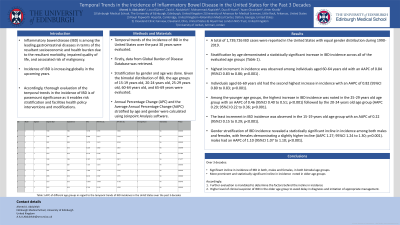Monday Poster Session
Category: IBD
P2579 - Temporal Trends in the Incidence of Inflammatory Bowel Disease in the United States for the Past 3 Decades
Monday, October 28, 2024
10:30 AM - 4:00 PM ET
Location: Exhibit Hall E

Has Audio

Ahmed A. A. Abdulelah, MD
University of Edinburgh
Edinburgh, Scotland, United Kingdom
Presenting Author(s)
Ahmed A. Abdulelah, MD1, Lina AlQirem, MD2, Zaid A. Abdulelah, MD3, Mohammad Alqaisieh, MD4, Dua' Al-Husni, MD5, Yazan Gharaibeh, MD6, Amer Khatib, MD7
1University of Edinburgh, Edinburgh, Scotland, United Kingdom; 2University of Arkansas for Medical Sciences, Little Rock, AR; 3Royal Papworth Hospital, Cambridge, England, United Kingdom; 4Hamilton Medical Center, Dalton, GA; 5Cleveland Clinic Foundation, Cleveland, OH; 6Royal Free London NHS Trust, London, England, United Kingdom; 7University of Jordan, Amman, 'Amman, Jordan
Introduction: Inflammatory bowel disease (IBD) is among the leading gastrointestinal diseases in terms of the resultant socioeconomic and health burden due to the resultant morbidity, impaired quality of life, and associated risk of malignancy. Accordingly, thorough evaluation of the temporal trends in the incidence of IBD is of paramount significance as it enables risk stratification and facilities health policy interventions and modifications.
Methods: The temporal trends of the incidence of IBD in the United States over the past 30 years were firstly evaluated by retrieving the relevant data from the Global Burden of Diseases 2019 database. The Annual Percentage Change (APC) and the Average Annual Percentage Change (AAPC) stratified by age and gender were calculated using Joinpoint Analysis software. Given the bimodal incidence pattern of IBD, the age groups of 15-19 years old, 20-24 years old, 25-29 years old, 60-64 years old, and 65-69 years old were evaluated when the incidence was stratified by age.
Results: Over the period of 1990-2019, a total of 1,739,726 IBD cases were reported in the United States with equal gender distribution. Stratification by age demonstrated a statistically significant increase in IBD incidence across all of the evaluated age groups. Notably, the highest increment in incidence was observed among individuals aged 60-64 years old with an AAPC of 0.84 (95%CI 0.83 to 0.86; p< 0.001), followed by individuals aged 65-69 years old with an AAPC of 0.82 (95%CI 0.80 to 0.83; p< 0.001). Among the younger age groups, the highest increase in IBD incidence was noted in the 25-29 years old age group with an AAPC of 0.46 (95%CI 0.40 to 0.51; p< 0.001) followed by the 20-24 years old age group (AAPC 0.29; 95%CI 0.22 to 0.36; p< 0.001). The least increment in IBD incidence was observed in the 15-19 years old age group with an AAPC of 0.22 (95%CI 0.15 to 0.29; p< 0.001). Gender stratification of IBD incidence revealed a statistically significant incline in incidence among both males and females, with females demonstrating a slightly higher incline (AAPC 1.27; 95%CI 1.24 to 1.30; p< 0.001). Whereas males had an AAPC of 1.10 (95%CI 1.07 to 1.10; p< 0.001).
Discussion: During the past 3 decades, the incidence of IBD in the United States witnessed a significant incline among males and females and across both bimodal age groups. However, the most significant increment in incidence was among the older age groups, thus mandating prompt recognition and intervention.
Disclosures:
Ahmed A. Abdulelah, MD1, Lina AlQirem, MD2, Zaid A. Abdulelah, MD3, Mohammad Alqaisieh, MD4, Dua' Al-Husni, MD5, Yazan Gharaibeh, MD6, Amer Khatib, MD7. P2579 - Temporal Trends in the Incidence of Inflammatory Bowel Disease in the United States for the Past 3 Decades, ACG 2024 Annual Scientific Meeting Abstracts. Philadelphia, PA: American College of Gastroenterology.
1University of Edinburgh, Edinburgh, Scotland, United Kingdom; 2University of Arkansas for Medical Sciences, Little Rock, AR; 3Royal Papworth Hospital, Cambridge, England, United Kingdom; 4Hamilton Medical Center, Dalton, GA; 5Cleveland Clinic Foundation, Cleveland, OH; 6Royal Free London NHS Trust, London, England, United Kingdom; 7University of Jordan, Amman, 'Amman, Jordan
Introduction: Inflammatory bowel disease (IBD) is among the leading gastrointestinal diseases in terms of the resultant socioeconomic and health burden due to the resultant morbidity, impaired quality of life, and associated risk of malignancy. Accordingly, thorough evaluation of the temporal trends in the incidence of IBD is of paramount significance as it enables risk stratification and facilities health policy interventions and modifications.
Methods: The temporal trends of the incidence of IBD in the United States over the past 30 years were firstly evaluated by retrieving the relevant data from the Global Burden of Diseases 2019 database. The Annual Percentage Change (APC) and the Average Annual Percentage Change (AAPC) stratified by age and gender were calculated using Joinpoint Analysis software. Given the bimodal incidence pattern of IBD, the age groups of 15-19 years old, 20-24 years old, 25-29 years old, 60-64 years old, and 65-69 years old were evaluated when the incidence was stratified by age.
Results: Over the period of 1990-2019, a total of 1,739,726 IBD cases were reported in the United States with equal gender distribution. Stratification by age demonstrated a statistically significant increase in IBD incidence across all of the evaluated age groups. Notably, the highest increment in incidence was observed among individuals aged 60-64 years old with an AAPC of 0.84 (95%CI 0.83 to 0.86; p< 0.001), followed by individuals aged 65-69 years old with an AAPC of 0.82 (95%CI 0.80 to 0.83; p< 0.001). Among the younger age groups, the highest increase in IBD incidence was noted in the 25-29 years old age group with an AAPC of 0.46 (95%CI 0.40 to 0.51; p< 0.001) followed by the 20-24 years old age group (AAPC 0.29; 95%CI 0.22 to 0.36; p< 0.001). The least increment in IBD incidence was observed in the 15-19 years old age group with an AAPC of 0.22 (95%CI 0.15 to 0.29; p< 0.001). Gender stratification of IBD incidence revealed a statistically significant incline in incidence among both males and females, with females demonstrating a slightly higher incline (AAPC 1.27; 95%CI 1.24 to 1.30; p< 0.001). Whereas males had an AAPC of 1.10 (95%CI 1.07 to 1.10; p< 0.001).
Discussion: During the past 3 decades, the incidence of IBD in the United States witnessed a significant incline among males and females and across both bimodal age groups. However, the most significant increment in incidence was among the older age groups, thus mandating prompt recognition and intervention.
Disclosures:
Ahmed Abdulelah indicated no relevant financial relationships.
Lina AlQirem indicated no relevant financial relationships.
Zaid Abdulelah indicated no relevant financial relationships.
Mohammad Alqaisieh indicated no relevant financial relationships.
Dua' Al-Husni indicated no relevant financial relationships.
Yazan Gharaibeh indicated no relevant financial relationships.
Amer Khatib indicated no relevant financial relationships.
Ahmed A. Abdulelah, MD1, Lina AlQirem, MD2, Zaid A. Abdulelah, MD3, Mohammad Alqaisieh, MD4, Dua' Al-Husni, MD5, Yazan Gharaibeh, MD6, Amer Khatib, MD7. P2579 - Temporal Trends in the Incidence of Inflammatory Bowel Disease in the United States for the Past 3 Decades, ACG 2024 Annual Scientific Meeting Abstracts. Philadelphia, PA: American College of Gastroenterology.

